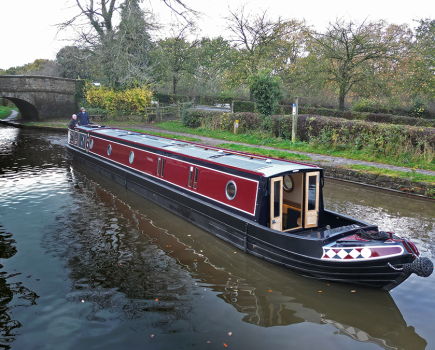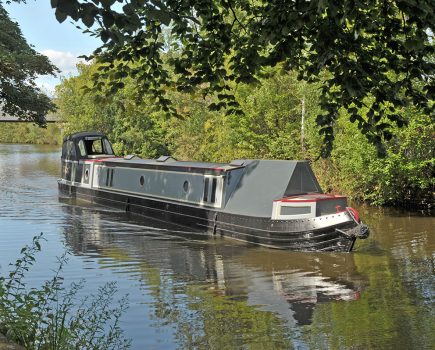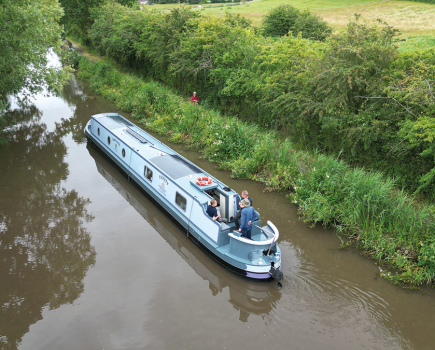Elsie Alice may look fairly standard on the outside, but step inside and there’s a vibrant interior that’s colourfully different from any other we’ve seen

You’d think the outside of a boat would tell you a lot about the inside, but you’d be wrong in many cases. Just like books, boats shouldn’t be judged by their covers.
Here’s a boat with a rather sober impression at first glance, but turns out to be bright, colourful and quirky when you go in. Or, as the owner, Claire Creek, puts it, she wanted a boat that was classy on the outside and ditsy on the inside.
Elsie Alice follows something of a trend away from wooden interiors. We’ve seen plenty with painted panels on the cabin sides or white rather than wooden ceilings, but this boat goes a step or two further.

Exterior
It’s a 50ft cruiser stern with a shell built by Soar Valley Steel Boats, based at Redhill Marina on the River Soar and close to Tristar Boats, who fitted it out.
In typical Soar Valley style, the bow is fairly sharply pointed, the roofline is low and there’s a pronounced tumblehome. There are scrolls in the ends of the handrails and the cants, and there’s a chunky grab handle built into the forward end of the cabin to help getting on and off at the bow. At the other end, the cabin has a nice diagonal line from the roof to the cruiser stern deck so it looks as though it ends properly rather than just coming to a stop.

This is a gas-free boat, so the locker at the bow provides storage. There are also lockers on both sides of the well deck, and the water tank is underneath. The stern deck is surrounded by a wide wooden taff rail, provideing somewhere to perch, and its supports are again set at an angle to give the boat a sense of purpose.
There’s one element of the steelwork you might not notice at first sight – a large horizontal plate on top of the rudder, just under the water. Soar Valley say they’ve been including this plate to the majority of their boats for a number of years. The idea is to give the boat a little extra power as the water is forced backwards rather than breaking the surface. It has the added advantage of making it easier to get back on the boat should you fall in, because there’s something big to step onto.
And so to the rather traditional looking colour scheme of dark blue cabin sides, a cream roof and coachlines and red handrails. It was painted by Tristar, who have recently converted a shed into a climate-controlled paintshop so boats can be shot-blasted and then spray-painted in ideal conditions for the hardening of the paint between coats. The final coat is applied by brush for a traditional finish.

Layout and fit-out
This boat follows the standard layout, with a saloon at the bow followed by the galley. Next is an off-corridor shower room followed by an unusual cabin. There’s a small area beyond at the stern for wardrobes and other cupboards.
The interior uses a lot of paint and underneath is birch ply, so the grain of the wood can still be seen. At one time, a painted interior might have been seen as a cheap option, but Jeremy Greenwood from Tristar says that’s not the case. Birch ply – which he likes as it’s European-made, rather than having to be shipped over from America – can be more expensive than oak-faced ply and getting a good paint finish takes more time than simple oiling or varnishing.

Most of the trim and posts are made from knot-free poplar. The floor is a lacquered engineered oak. The fit-out is fairly straightforward, and solidly built.
Saloon
Step inside from the well deck and you’re immediately struck by how bright and cheerful this boat is. It looks as though it could have come straight from the pages of a glossy interiors magazine.

The two steps down into the boat have lifting treads for storage, with the top one designed specially to take Claire’s sewing machine.
White is the main colour, but there are splashes of brighter paints here and there to highlight pieces of furniture or draw the eye. Below the gunwales, the boards have been routed to look like tongue and groove. In the saloon, the cupboard and shelving units are painted in a teal blue, while the doors have the first of many heart-shaped motifs.
Seating comes in an L-shaped built-in bench, which converts into a bed. Underneath, there are drawers and a cupboard with a drop-down door, all have a blue Formica laminate set into the fronts, designed to take the odd knock from people’s shoes.

A table on Desmo legs turns this into a dinette. It has the same laminate set into the top, which is fitting as it reminds Claire of her grandmother’s kitchen table. The boat is named Elsie Alice after her.
But it’s the little details that bring the whole design to life. Every cupboard and drawer in the boat has a ceramic knob, and they’re all different. No curtain is the same, either. Claire made them herself – her favourite is a patchwork of off-cuts. They’re held up by little alligator clips because it was easier than putting proper heading tape on each one, but, in fact, they suit the boat down to the ground.
Galley

A C-shaped bulkhead divides the saloon from the galley and features one of many heart-shaped cut outs. The galley cupboards and drawers are a riot of colour, painted seemingly at random in pink, yellow, green and blue, and teamed with different coloured handles. Even though this is a relatively small space, there’s plenty of storage and even extra drawers in the kickboards.
The cupboards are topped with attractive beech worktops with a drainer routed in, and the sink is a Belfast style with brass taps. There’s more colour in the splashbacks, which are wallpaper covered in glass.
Claire’s one extravagance is the range cooker, a Heritage Uno diesel-fired set up. Claire’s is the base model just for cooking, but more expensive versions run heating and hot water. Its cream colour, the only one available, looks relatively subdued compared with what’s around it. It does look smart, though, and suits the space.

Other equipment includes a tall Shoreline fridge-freezer and a washing machine. An individually switched extractor fan has been built into the mushroom vent in the ceiling. The sockets are brushed chrome and some have USB charging sockets for phones and tablets.
Shower room
The shower room is an off-corridor design, preferred by Claire to a walk-though because she’ll often be on board with one of her sons. The shower is a good sized square unit with cupboards and shelves alongside. A smart white rectangular basin sits on top of a green painted unit, contrasting with the pink wall behind. There’s also a white heated towel rail.

The loo is a Thetford cassette, accessed through a small door in the corridor. This doesn’t have a handle as such, instead there’s a heart-shaped cut-out.
Cabin
This is one of the more unusual designs we’ve seen, yet one of the most appealing. The bed, 4ft wide, is enclosed in what Claire calls a bed box. It’s almost like having a four-poster because the bulkhead that divides the bed space from the corridor has curtains for privacy. The head of the bed has a luxurious fabric head board and a couple of reading lights. At the foot there are a couple of high level cupboards with a shelf underneath.

Under the bed is storage and a cupboard with a flip-down door, providing somewhere to keep spare loo cassettes. There are also a couple of drawers. Other storage in the cabin is at the stern of the boat. There’s a full height cleaning cupboard, housing the fuse panel. On the opposite side, there’s a wardrobe with hanging space and other cupboards alongside the steps up to the back deck.
Technical
Elsie Alice is fairly straightforward. It’s powered by a Beta 38 engine – plenty for a boat of this size. There’s a good sized battery bank, of five 100Ah batteries and a 240-volt supply comes from a Mastervolt 2.2kW Mass Combi inverter. Mastervolt now sell everything you need in one kit, the Comfort System, which includes the inverter, distribution panel, a touch-screen control panel and shoreline connections. Lighting throughout uses LED bulbs, to reduce power consumption.

The boat has a solar panel to keep the batteries charged for a good proportion of the year. It’s a 240-watt panel at 50 volts, with a Victron MPPT controller. Heating and hot water are provided by a Webasto diesel boiler.
On the water
The big stern deck is a sociable place to be and, as mentioned previously, the wide wooden taff rail provides a perch for the crew.

Handling is excellent – the boat turns on a sixpence. Put the tiller hard over, apply a bit of power and the bow moves over straight away. Who needs bow thrusters?
The tiller is at a comfortable height, but (as is often the case on cruiser sterned boats) the Morse control is set rather low down. The instrument panel is hidden behind a rear door, which you might find annoying if you’re the sort who likes to know how many revs you’re doing or to keep an eye out for any warning lights. These are minor matters, though.
Conclusion

Elsie Alice’s character, charm and personality are much bigger than its physical 50ft length. It’s no surprise Michelle Greenwood at Tristar says their team really enjoyed working on it. And even though it’s just 50ft long, it fits in everything and feels spacious.
What’s more, this boat, at £94,000, is great value for money. Some of those design touches cost just a couple of pounds.
It’s not easy to put together an interior like this. Done badly, it could look disjointed and messy, but Elsie Alice gets it exactly right and shows how a customer and builder working together really can deliver. Claire says she and Michelle clicked – she had the ideas and Michelle brought them to reality.

The boat demonstrates what can be done with imagination, flair and perhaps a little bravery. It’s a fairly standard shell with an uncomplicated fit-out in many ways, but the end result is far greater than the sum of its parts.
So you can’t judge a book by its cover, and when you next see a boat with a classy exterior colour scheme, just consider the possibility it could be disguising intense ditsiness on the inside.
___________________
More Boat Tests:
Betty, runner-up at Crick 2016
Silver Melody, three-time Crick winner
Image(s) provided by:
Archant







